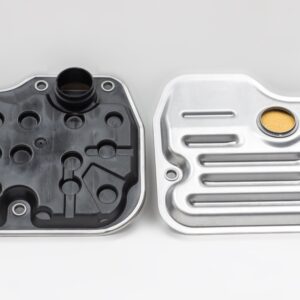If you’re a seasoned DIYer, you’ll likely know that transmissions are heavy and can weigh as much as 400 pounds.
A transmission jack is designed to support the transmission when it’s removed or installed. It has four wheels on its base for maneuverability and four prongs on its platform, which typically supports the transmission by its pan, and there will be ratchet strap attachment points so the transmission can be secured to the platform. Be careful to securely tie the transmission to its platform or it might shift suddenly and then fall.
Transmission jacks can usually carry around 600 and 4,000 pounds, depending on the type you buy. But considering the types of transmission jacks on the market, which should you buy?
How Does a Transmission Jack Work?
Let’s start by taking a quick look at how transmission jacks work. There are two varieties of transmission jacks: hydraulic and pneumatic. Hydraulic pressure jacks use a hydraulic pump to lift heavy loads, while pneumatic pressure jacks use pressurized air.
A pneumatic transmission jack can lift and lower heavy transmissions very easily, but they also have some drawbacks, such as:
- They are more expensive than manual or hydraulic transmission jacks.
- They require an air compressor and a hose to operate, and air hoses get in the way.
- They are rather noisy and the air exhaust can raise floor dust.
- They can be dangerous if not used properly and can cause injury or damage to the vehicle, the transmission, or the person using them.
A pneumatic transmission jack can lift and lower heavy transmissions very easily, but are more expensive than manual or hydraulic transmission jacks.
–Richard McCuistian, ASE Certified Master Automobile Technician
Hydraulic transmission jacks are generally easier to operate and more affordable. They aren’t as heavy-duty as pneumatic pressure jacks, but your average DIYer won’t really need a heavy-duty pressure jack unless they plan on working with particularly heavy transmissions. In fact, there’s even a transmission jack adapter available for casual DIYers who have a regular floor jack that can safely carry their transmission’s weight.
Other than their high carrying capacity, transmission jacks have their own unique design. There are four prongs on the top platform that can be adjusted according to the shape of the transmission. In addition, there are also adjustment knobs you can turn to change the angle from side to side and front to back maneuvering the transmission into place.

How To Choose the Right Transmission Jack
When choosing the right transmission jack for your needs, there are a few things to consider:
Height
Transmission jacks have a minimum and maximum lifting height to accommodate different vehicles and needs. So when buying a transmission jack, you’ll need to bust out the tape measurer and see how tall your transmission jack has to be.
It should be tall enough to support your transmission during installation and removal while also fitting in the space you have. There are even low-lift transmission jacks for those who don’t need to remove the transmission while the vehicle is on a lift.
Maximum Weight Capacity
Of course, there’s also maximum weight capacity to consider. An average transmission will weigh 100 to 400 pounds. Unless you work with heavy machinery, a transmission jack with a weight capacity of 600 should do the trick.
Quality
Because they’re meant to carry heavy equipment, transmission jacks should ideally be high quality. Try to buy a transmission jack you can trust. Go for transmission jacks made with durable steel. It’s also good to look at the base, casters, and locking mechanisms to make sure they’re up to snuff for your needs.
Maneuverability
Maneuverability is also very important for a transmission jack, especially if you have limited space. Take into account how compact the jack can be when not in use and check that the wheels roll smoothly.

How To Use a Transmission Jack
To use your transmission jack, follow these steps:
Step 1
First, prepare the vehicle by making sure it’s on a secure, level surface. The parking brake should be engaged, the wheels should be chocked, and the vehicle should be standing on jack stands.
Step 2
Next, position the transmission jack right underneath the transmission. Adjust the jack’s height to properly support the transmission. If you can spot the transmission’s center of gravity, it should help you determine where the jack should go.
Step 3
After that, raise the engine a bit with floor jacks so it doesn’t weigh down the transmission. Keep the transmission level at all times to avoid damaging the gears. Adjust the prongs on the platform accordingly to safely support the transmission. Secure the transmission to the jack with a chain and J-bolt or a ratchet strap. Once it’s out, carefully move the transmission to its new location.
You can reverse these steps to reinstall the transmission. Simply guide the transmission back to its original place and bolt it to the engine. Once it’s secure, slowly lower the jack and remove it from beneath the vehicle.
Transmission jacks can be rather niche, but they provide a great service for those who need it. While you likely won’t ever need a heavy-duty transmission jack, you might want to buy a more lightweight option anyway just to be safe.
Any information provided on this Website is for informational purposes only and is not intended to replace consultation with a professional mechanic. The accuracy and timeliness of the information may change from the time of publication.




























